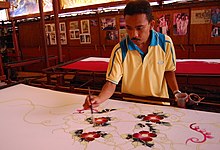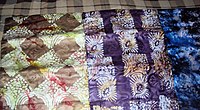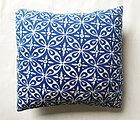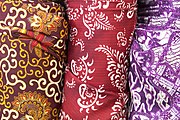Digital Media Concepts/Batik
 | |
 | |
| Section | Art |
|---|---|
| Origin | Indonesia |
Batik (/bəˈtēk,ˈbadik/) is an art that comes from Indonesia. It is also known as a dye technique that is popular in and well-known in the West because of its wonderfully creative medium. Decorating art this way, using wax and dye, has been praised for a long time. In the island of Java, batik is basically a tradition and it uses the finest cloths of Batik is made from Java. The word Batik comes from the language Javanese that means to dot.
Batik has grown to become modern now called contemporary batik. It is different from traditional ways. For instance, the artist may use etching, discharge dyeing, stencils, and different utensils like dye and wax. Different wax recipes is different and have a variety of values with silk, cotton, wool, leather, paper or even wood and ceramics.
Batik is known from history to be the most expensive and subtle for their methods. The very broad range of techniques is available for the artist to discover flexible and amazing techniques to be creative. [1]
Etymology
[edit | edit source]Batik originated from the Javanese language which is “Amba” which means to write and “tie” which means dot. The dot is called “check’” which is an important part of batik. In Javanese, it is called “trik” or “tank” which means cloth that is designed with dot patterns. The word “ambatik” may also be translated as a piece of fabric that is made of dots from the night or certain chemicals. To summarize, Batik is basically cambric fabric, cotton or silk that uses wax or malam (in Javanese) as borders in canting tool. [2]

History of Batik
[edit | edit source]From over 2000 years ago, traces of Batik were discovered from the Far East, Middle East, Central Asia, and India. It is widely known that these areas developed Batik without other cultures' influences and/or trading. However, some resources also presume that Batik originated from Asia or around the islands of the Malay Archipelago or west of the Middle East. As early as the Sui Dynasty (AD 581-618), China was known to practices Batik designs. Silk batik has also been found in Nara, Japan in forms of screens and these clothes are connected to the Nara period (AD 710-794). It very likely the Chinese artist made designs in silk cloth. These designs are covered with trees, animals, flute players, hunting scenes, and stylized mountains.
There is no support saying that old cotton batiks are in India, however, frescoes in the Ajanta caves displays head wraps and clothing which have similar designs to batik. In Java and Bali's temple ruins, they have several artifacts which use batik as their garment designs. By 1677, evidence of export trade which are mostly silk from China to Java, Sumatra, Persia, and Hindustan. In Egypt, linen or several woolen cloths are discovered to have white patterns on a blue ground and known as early at the 5th century A.D. They are made possible in Syria, Egypt. In Central Africa, resist dyeing is known by using cassava and rice paste for centuries in Yoruba tribe of Southern Nigeria and Senegal.
In Indonesia, specifically, the island of Java is where batik becomes the peak of popularity and success. The Dutch brought Indonesia craftsmen to teach batik to Dutch warders in several factories in Holland in 1835. The Swiss also produces an imitation of batik in the early 1940s. A wax block of printing is also developed in Java by using a cap.
By the early 1900s, the Germans produced Batik in mass production. For instance, the form of batik and also handmade batik are now popular around the world. Batik production has become modernized by using computational techniques. [3]
Production
[edit | edit source]To make a batik, selected areas of the cloth are blocked out by brushing or drawing hot wax over them, and the cloth is then dyed. The parts covered in wax resist the dye and remain the original color. This process of waxing and dyeing can be repeated to create more elaborate and colorful designs. After the final dyeing, the wax is removed and the cloth is ready for wearing or showing. [4]
Batik Tulis
[edit | edit source]
Batik tulis has a very high value because it is authentic, one will not be the same as the other. It is handmade by a very skilled person and purely use canting as its main tool. It takes full focus to make the least mistake as possible and with multiple drawing repetition, it will have certain flaws that are considered as art. The time needed is from either two weeks to two years. It costs starting from 600,000 IDR (42 USD) and up to millions of rupiah (thousand of dollars).
Batik Stamp
[edit | edit source]
In the 19th century, Batik demand was high. The producer creates this method to quickly increase production. They use pieces of iron or copper and malam to stamp it on the Mori cloth. It usually has a simple design and can be stamped over and over. It is usually more affordable and costs around 300.000 IDR (22 USD).
Batik Sablon
[edit | edit source]This quality is less good than batik cap. This method is different from batik printing. It uses similar methods like screen printing. The utensil they use are plangkan and rakel. The process is cheaper and faster because it does not use malam. It is considered as a low-quality batik although with very precise patterns. Producers would prefer this method as a mass production. In a day, it can produce thousands of batik.
Batik Print
[edit | edit source]It uses a textile print machine. People often call it imitating batik. Foreign countries can use this machine to make batik at a lower price. For example, China makes batik printing cloth which is very affordable with the essence of Indonesian Batik. It usually costs around 80,000 IDR to 120,000 IDR ( 6 to 10 USD )
Batik Lukis
[edit | edit source]
Although the art value of this method is very high, people doubt to call this in the batik department. This method uses paintbrush and oil paint on top of mori fabric. Although this type of batik is hard to find, it usually is very expensive. It can cost from 300,000 IDR to 1,000,000 ( 20 - 75 USD ). The painter has to dip the paintbrush on the paint that is heated multiple times. The trait that this batik have is bold colors and strokes from the paintbrush. The pattern looks more like a painting and more contemporary.
Popular Batik designs
[edit | edit source]Indonesia has a variety of Batik designs, every village has their own specific characteristics. [5]

| Name | Description | Geographic Location |
|---|---|---|
| Batik Mega Mendung | Mega Mendung means cloudy. There are 7 shades of blue. The cloud means spiritual, the red and blue means the traits of Cirebon inhabiters which is assertive. It tells a message about people should be patient and not encourage fights. | Cirebon, Jawa Barat |
| Batik Dolly | Dolly is a village that is remotely located in Surbaya. The name of the small area is Gang Jarak, named after the plants that grow there. Dolly is first introduced in 2014. It usually has butterflies and Jarak leaf as patterns. | Gang Jarak, Surabaya |
| Batik Loreng Ondel-Ondel | Jakarta is the capital city who has their own batik design. One of the most popular ones is the pattern ondel-ondel. This production is located in Palmerah, Bendungan Hilir, Karet Tengsin, and Kebon Kacang. If you want to see it, you can find it in Museum Tekstil in Tanah Abang, Jakarta Pusat. The pattern reflects on Betawi people who are rousing. The color that dominates are red, bright yellow, and light purple. The figure ondel-ondel and the color choices hope to make the wearer have a happy life and filled with kindness. | Jakarta, Jawa Barat |
| Batik Kujang Kijang | The element kujang and kijang is famous in Bogor. Kujang is a traditional weapon from Sunda tribe and also a symbol of the Bogor. Kijang is an animal that is usually found in Bogor Palace. The design is usually drawn side to side and facing 4 corners. The meaning of this design relates to the safety and shelter from all 4 cardinal directions. | Bogor, Jawa Barat |
| Batik Palembang | One of the unique traits from this design is the usage of flowers and humans. You can only find flower patterns from Palembang Batik. It is also influenced by several cultures such as China, Melayu and the Kerjaan Islam. It also use simetric lines. The meaning of this pattern is holiness, grace, and luck. | Palembang, Sumatra |
| Batik Tabir | At a glance, the pattern looks like the batik Palembang. However, there is no flowers and human figues in this pattern. The flowers used in the patterns are tanjung, kesumbo, cempaka, sunflower. The colors that dominates is red, yellow, and green. Tabir is cloth used as partition. The pattern is inspired by the tabir shape that has a pattern from the top to the bottom. Cloth that is used is China silk. | Riau, Pekanbaru |
| Batik Gamolan | Gamolan is a musical instrument from Lampung and is different from gamelan that is from Jawa. The usage of this pattern is used to introduce this musical instrument made from bamboo to citizens. | Lampung, Sumatra |
Batik based on other's culture influence
[edit | edit source]The art of Batik as well as its techniques is famous in Indonesia. However, the history of it is debatable. Some resources mention that Batik originated from Persia and Egypt which is why it is not only known in Indonesia but also Thailand, India, Japan, Sri Lanka, and Malaysia.
- Batik Belanda
Batik Belanda is a kind of batik that develops between 1840-1940. At first, this batik is for the citizens of the Dutch and indo-dutch. The users itself was also limited but then spreadd to the chinese and javanese royals. [6]
Batik Hokokai is a kind of batik tulis that originated from the Pekalongan between 1944-1945. The main attractions of batik Hokokai is the flower patterns. Those flowers include Dahlia, Chrysanthemum, Peony, Sakura, and Orchard. It is also decorated with butterflies. The cloth is also divided into two parts which is Pagi and Sore. Batik Hokokai is usually colorful and not purely kejawen, although it also have Java elements in it. It is inspired by the Japanese who is colonizing Indonesia at the time. The meaning of Batik Hokokai is seen from the history of the nation's fight for independence.[7]
Gallery
[edit | edit source]-
Indonesian sarong from Java, c. 1880, Honolulu Academy of Arts
-
Skirt from Cirebon, Java, early 20th century, coton, 'tulis' batik
-
Batik Truntum
-
ASSORTED BATIK DESIGN
-
Batik Kawung Cushion
-
Batik Trusmi Cirebon (20)
-
Detailed Gajah Oling motif in Batik Banyuwangi
-
COLLECTIE TROPENMUSEUM Katoenen wikkelrok met geometrisch patroon TMnr 5713-2
-
Batik Tiga Negeri Lasem Tulis
-
Batik Trusmi Cirebon (14)
-
Batik
-
Batik Besurek Bengkulu
-
Batik pedalaman - sidha drajat
-
Batikyogya 01
-
De inlandsche kunstnijverheid in Nederlandsch Indië (1912) (14580812278)
-
De inlandsche kunstnijverheid in Nederlandsch Indië (1912) (14580657679)
-
Batik Indonesia
-
Batik pattern - bangau
-
Batik Banyuwangi Gajah Oling
-
Batik Trusmi Cirebon (21)
External Links
[edit | edit source]References
[edit | edit source]- ↑ "What Is Batik?" The History of Batik | The Batik Guild. Accessed March 03, 2019. https://www.batikguild.org.uk/batik/what-is-batik.
- ↑ "Batik." Sejarah Batik Malaysia Motif Dan Keanekaragamannya | Batik Tradisional Indonesia. Accessed March 03, 2019. http://batikdan.blogspot.com/2011/06/batik.html.
- ↑ "The History of Batik." The History of Batik | The Batik Guild. Accessed March 03, 2019. https://www.batikguild.org.uk/batik/history-of-batik.
- ↑ "Pemoeda." Batik Parang – Benarkah Ini Batik Bermotif Senjata Parang? Accessed March 03, 2019. https://www.pemoeda.co.id/blog/batik#1. Pengertian Batik, Asal Muasal & Makna.
- ↑ Batiqa. "Mengenal Ragam Batik Populer Indonesia." Https://www.batiqa.com/. Accessed March 03, 2019. https://www.batiqa.com/read-article/mengenal-ragam-batik-populer-indonesia.
- ↑ Batiqa. "Mengenal Ragam Batik Populer Indonesia." Https://www.batiqa.com/. Accessed March 03, 2019. https://www.batiqa.com/read-article/mengenal-ragam-batik-populer-indonesia.
- ↑ Pemoeda."Batik Parang – Benarkah Ini Batik Bermotif Senjata Parang?" Accessed March 03, 2019. https://www.pemoeda.co.id/blog/batik-hokokai.





















